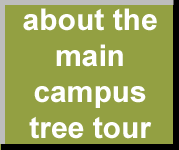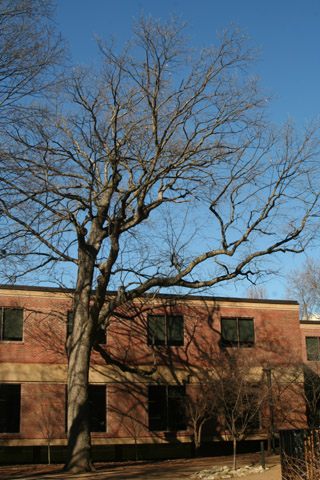
|

|

|

|
An individual instance of Quercus muehlenbergii (chinquapin oak)

Permanent unique identifier for this particular organism:
http://bioimages.vanderbilt.edu/vanderbilt/7-282
Notes:
This large tree grows between Rand/Sarratt and the parking lot behind Buttrick Hall, near the entrance to the post office.
Quercus muehlenbergii (chinkapin oak), Quercus michauxii (swamp chestnut oak), Quercus bicolor (swamp white oak), and Quercus montana (chestnut oak) have similar leaves but can be distinguished by careful examination as well as by their habitat, bark, and acorns. The first three of these species will be seen in this tour. In the wild, chinkapin and chestnut oaks would be found in uplands, while swamp white and swamp chestnut oaks would be found in wetlands. Therefore it is most important to be able to distinguish between these pairs.
The tips of the lobes (or large teeth) of chinkapin oak leaves have small glands at their tips. The glands are best seen using a hand lens. Chestnut oak leaf lobes do not have these glands. The bark of chinkapin oaks tends to flake off in strips, while the bark of large chestnut oaks has deep furrows. When fully ripe, chinkapin oak acorns are small and nearly black with light colored caps. Chestnut oak acorns are more of a chestnut brown, large and somewhat bullet-shaped, and have more conical caps. Chestnut oaks are also typically found on dry ridge tops and slopes, while chinkapin oaks are found in more moderate conditions.
Chinkapin oak is fairly common in this area, although there are few examples on campus.
Quercus muehlenbergii (chinkapin oak), Quercus michauxii (swamp chestnut oak), Quercus bicolor (swamp white oak), and Quercus montana (chestnut oak) have similar leaves but can be distinguished by careful examination as well as by their habitat, bark, and acorns. The first three of these species will be seen in this tour. In the wild, chinkapin and chestnut oaks would be found in uplands, while swamp white and swamp chestnut oaks would be found in wetlands. Therefore it is most important to be able to distinguish between these pairs.
The tips of the lobes (or large teeth) of chinkapin oak leaves have small glands at their tips. The glands are best seen using a hand lens. Chestnut oak leaf lobes do not have these glands. The bark of chinkapin oaks tends to flake off in strips, while the bark of large chestnut oaks has deep furrows. When fully ripe, chinkapin oak acorns are small and nearly black with light colored caps. Chestnut oak acorns are more of a chestnut brown, large and somewhat bullet-shaped, and have more conical caps. Chestnut oaks are also typically found on dry ridge tops and slopes, while chinkapin oaks are found in more moderate conditions.
Chinkapin oak is fairly common in this area, although there are few examples on campus.

|

|
|
Load database and switch to thumbnail view
Use this stable URL to link to this page:
http://bioimages.vanderbilt.edu/vanderbilt/7-282.htm
This organism is a living specimen that is part of the Vanderbilt University Arboretum with the local identifier 3-140.
This particular organism is believed to have managed means of establishment.
This organismal entity has the scope: multicellular organism.
Identifications:
Quercus muehlenbergii
Engelm.
sec. fna.org 1993
common name: chinquapin oak
family: Fagaceae
Identified 2013-12-11 by Steven J. Baskauf
Location:
Vanderbilt University, Nashville, Davidson County, Tennessee, US
Click on these geocoordinates to load a map showing the location: 36.14603°, -86.80286°
Coordinate uncertainty about: 10 m.
Location of individual determined from GIS database.
Occurrences were recorded for this particular organism on the following dates:
2013-12-11
2014-09-03
The following images document this particular organism.
Click on a thumbnail to view the image and its metadata. Load database and enable navigation by taxon and organism.
| Image | View |

|
whole tree (or vine) - general |

|
whole tree (or vine) - general |

|
whole tree (or vine) - winter |